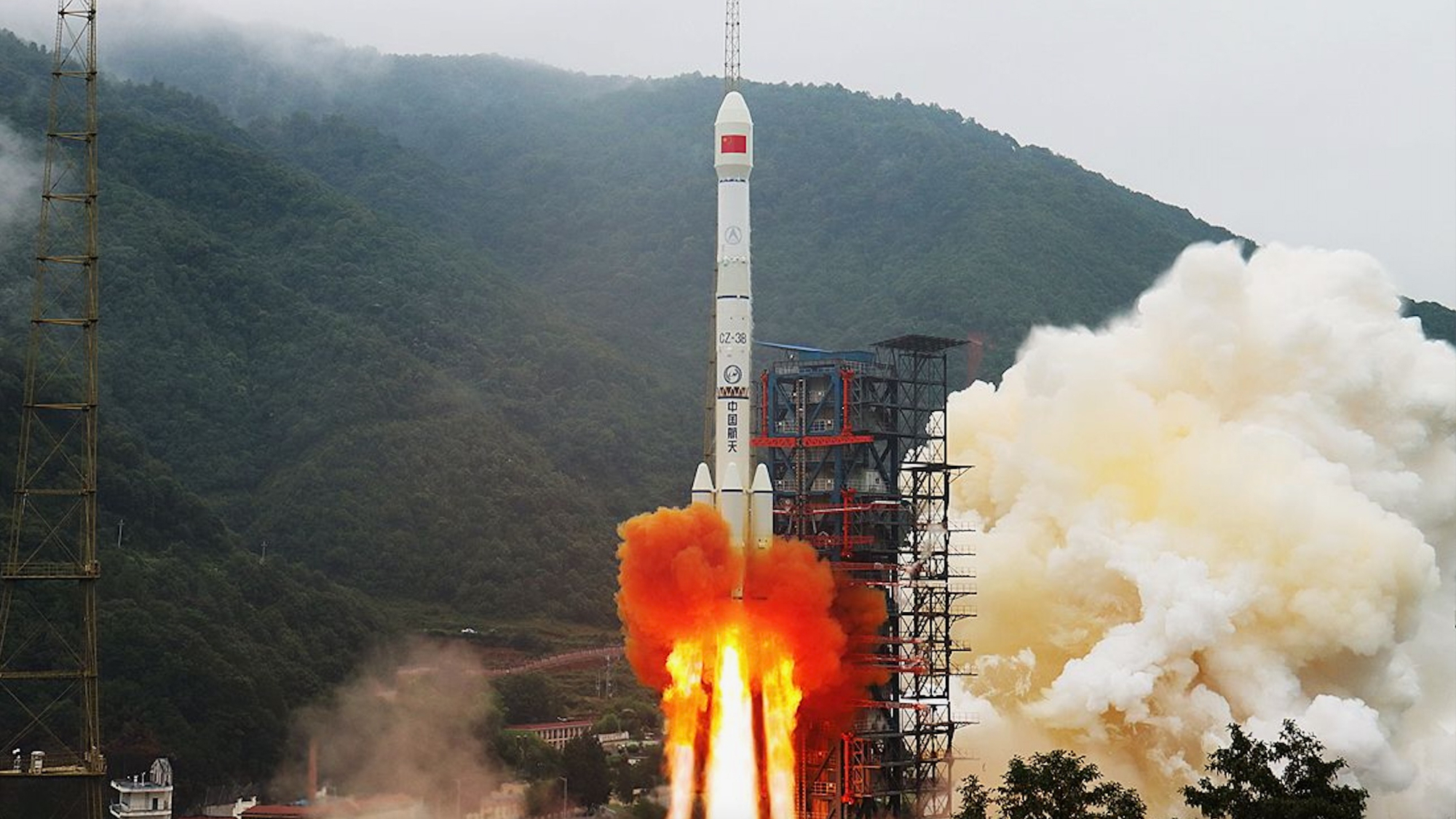John Glenn: America's 1st space hero
When it comes to American space exploration, John Glenn had the right stuff, making history in 1962 as the first American to orbit Earth.
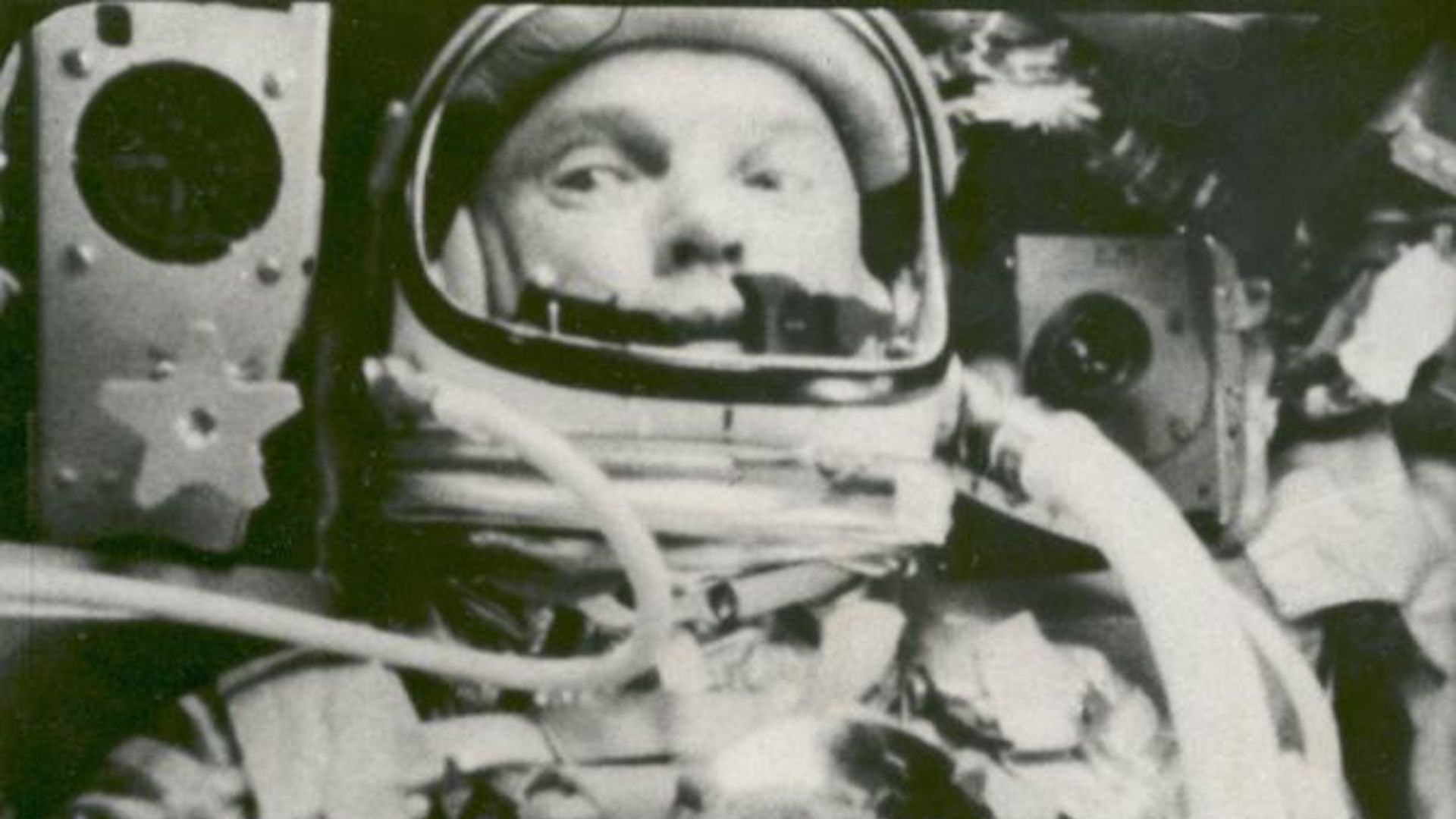
Editor's note: John Glenn, a legendary NASA astronaut and American hero, died on Dec. 8, 2016, at age 95. Read our full obituary here.
John Glenn was a NASA astronaut who, in 1962, made history by becoming the first American to orbit Earth. He was one of the "Mercury 7," NASA's first astronaut class.
Glenn was a vital part of the U.S. space program, and his orbit around the planet was an important equalizing step in the space race between the U.S. and the Soviet Union after cosmonaut Yuri Gagarin became the first human in space in April 1961. Whereas Gagarin made just one orbit of Earth, Glenn made three, perhaps as a result of a desire to always take things to the next level.
"Glenn was a man who seemed to be driven by one overriding purpose: to utilize his abilities to the fullest extent possible and to increase what he once called 'mankind's ever-broadening store of knowledge. He welcomed the unknown and longed to explore it," space historian Andrew Chaikin wrote in a 2016 article for Scientific American. "Without planning it, or even realizing it, he was preparing for his Mercury mission for most of his adult life.'
By showing the world that the United States was a serious contender in the space race with the Soviet Union, Glenn became an instant hero, NASA noted in a profile of Glenn.
Related: John Glenn, first American in orbit (photos)
Glenn was still pushing the limits later in life: In October 1998, at 77 years old, he became the oldest man ever to venture into space. The record stood for 23 years, until it was claimed by 90-year-old "Star Trek" actor William Shatner in October 2021. However, the record for the oldest person in space was claimed from Glenn by 82-year-old Mary Wallace ("Wally") Funk in July 2021, though Shatner broke that record a few months later.
After retiring from the space program, Glenn served four terms as a U.S. senator from Ohio.
John Glenn's early life
Glenn was born John Herschel Glenn Jr. in Cambridge, Ohio, on July 18, 1921, to John and Clara Glenn. The family moved to New Concord, Ohio, when Glenn was 2 years old.
According to Biography.com, Glenn began to show an interest in aeronautics at an early age. He graduated from New Concord High School in 1939 and went to Muskingum College. In addition to his early scientific curiosity, Glenn developed an early sense of patriotism that would influence his decision to leave school and serve his country in the second world war. According to Britannica, in 1942, Glenn joined the U.S. war effort when he enlisted in the U.S. Navy Reserve.
The future astronaut joined the U.S. Marine Corps in 1943 and flew 59 missions in the South Pacific during World War II. Later, during the Korean War, Glenn flew 90 missions, and during the final nine days of the conflict, he downed three Soviet MiG aircraft.
According to History.com, Glenn was a decorated pilot who flew nearly 150 combat missions over the course of World War II and the Korean War. In 1954, Glenn graduated from the U.S. Naval Test Pilot School in Patuxent River, Maryland, and then piloted the F-8 fighter during test flights.
Glenn broke his first record in July 1957, when, as a project officer of the F-8U Crusader, he flew the first transcontinental flight at an average supersonic speed, according to NASA. Glenn flew nonstop from the Naval Air Station in Los Alamitos, California, to Floyd Bennett Field in New York in just 3 hours, 23 minutes. Glenn was promoted to lieutenant colonel in 1959 and accumulated nearly 9,000 hours of flying time, with around a third of that in jets.
John Glenn's orbital flight
When did John Glenn orbit Earth?
John Glenn orbited Earth on Feb. 20, 1962, as part of the Mercury-Atlas 6 mission.
On April 9, 1959, Glenn was selected with six others to NASA's first astronaut class, which would go on to be called the Mercury 7. This "original seven," as they were also known, included Wally Schirra, Donald "Deke" Slayton, Scott Carpenter, Alan Shepard, Virgil “Gus” Grissom and L. Gordon Cooper Jr.
After his selection as a Mercury astronaut, Glenn was assigned to the NASA Space Task Group at Langley. The Space Task Group was moved to Houston in 1962 and became part of the NASA Manned Spacecraft Center, which is now Johnson Space Center.
Though Shepard and Grissom made the first and second U.S. suborbital flights, respectively, it was Glenn, who had been backup on those missions, who was selected to make the first orbital flight as part of the Mercury-Atlas 6 mission, in the Friendship 7 space capsule.
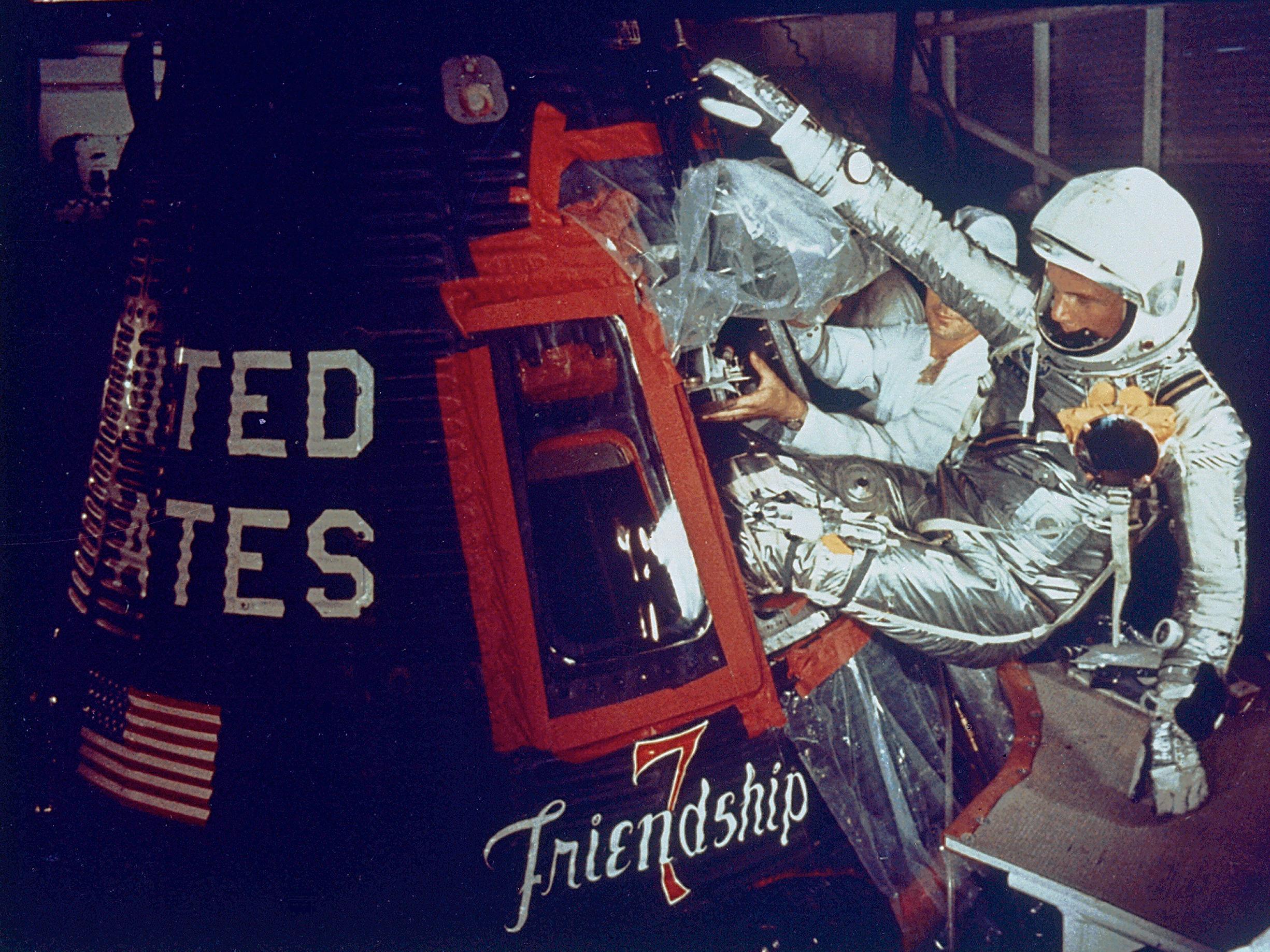
According to NASA, the objectives of the mission were to "place a man into Earth orbit, observe his reactions to the space environment, and safely return him to Earth to a point where he could be readily found. The Mercury flight plan during the first orbit was to maintain optimum spacecraft attitude for radar tracking and communication checks."
Glenn and Friendship 7 blasted off from Cape Canaveral Launch Complex 14 in Florida on Feb. 20, 1962, at 9:47 a.m. EST. The mission lasted 4 hours, 55 minutes and 23 seconds. During that time, according to NASA's Mercury-Atlas 6 mission page, Glenn traveled 75,679 miles (121,794 kilometers) around Earth, making three orbits of the planet at an average speed of 17,544 mph (28,234 km/h) — about 14 times as fast as the top speed of the F-8 fighter jets he had test-piloted eight years earlier.
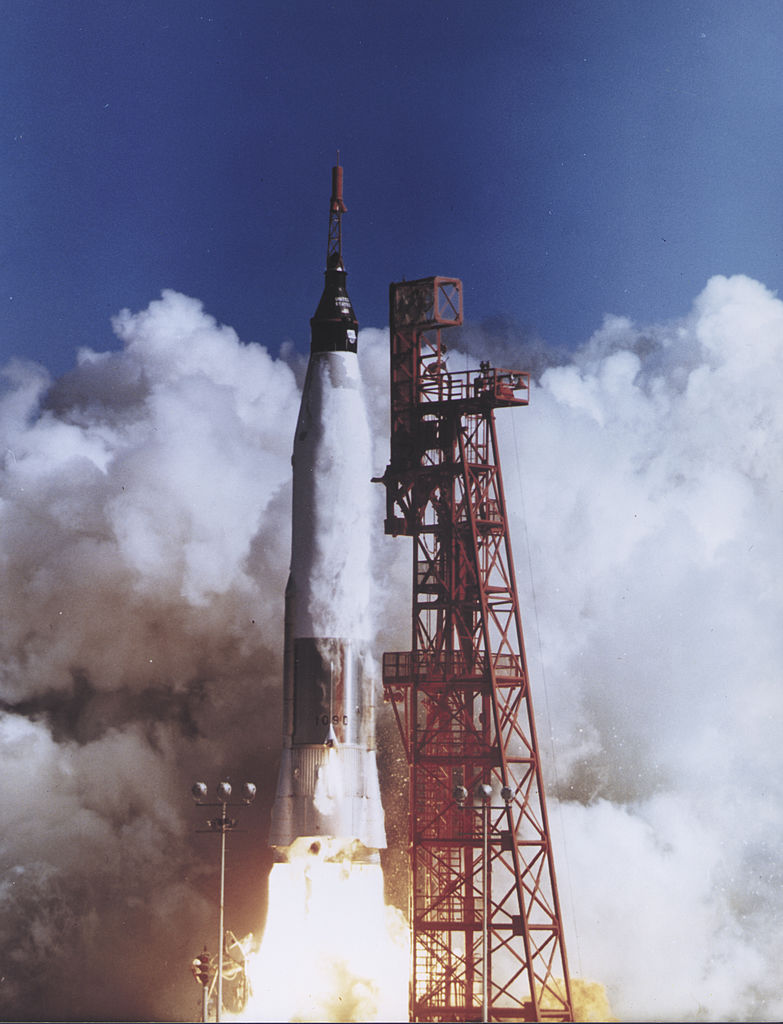
Toward the end of the final orbit, mission control received a signal from Friendship 7 that the heat shield at the base of the capsule was loose, according to History.com. If the heat shield had failed to absorb the immense heat from reentry, Glenn and Friendship 7 would have been incinerated. To ensure that the heat shield remained in place, the decision was made not to jettison Friendship 7's retrorockets, as it was thought that these would hold the heat shield in place. As Glenn made a fiery descent to Earth, the straps holding the retrorockets snapped, with excess friction causing Glenn to lose radio communication with ground control.
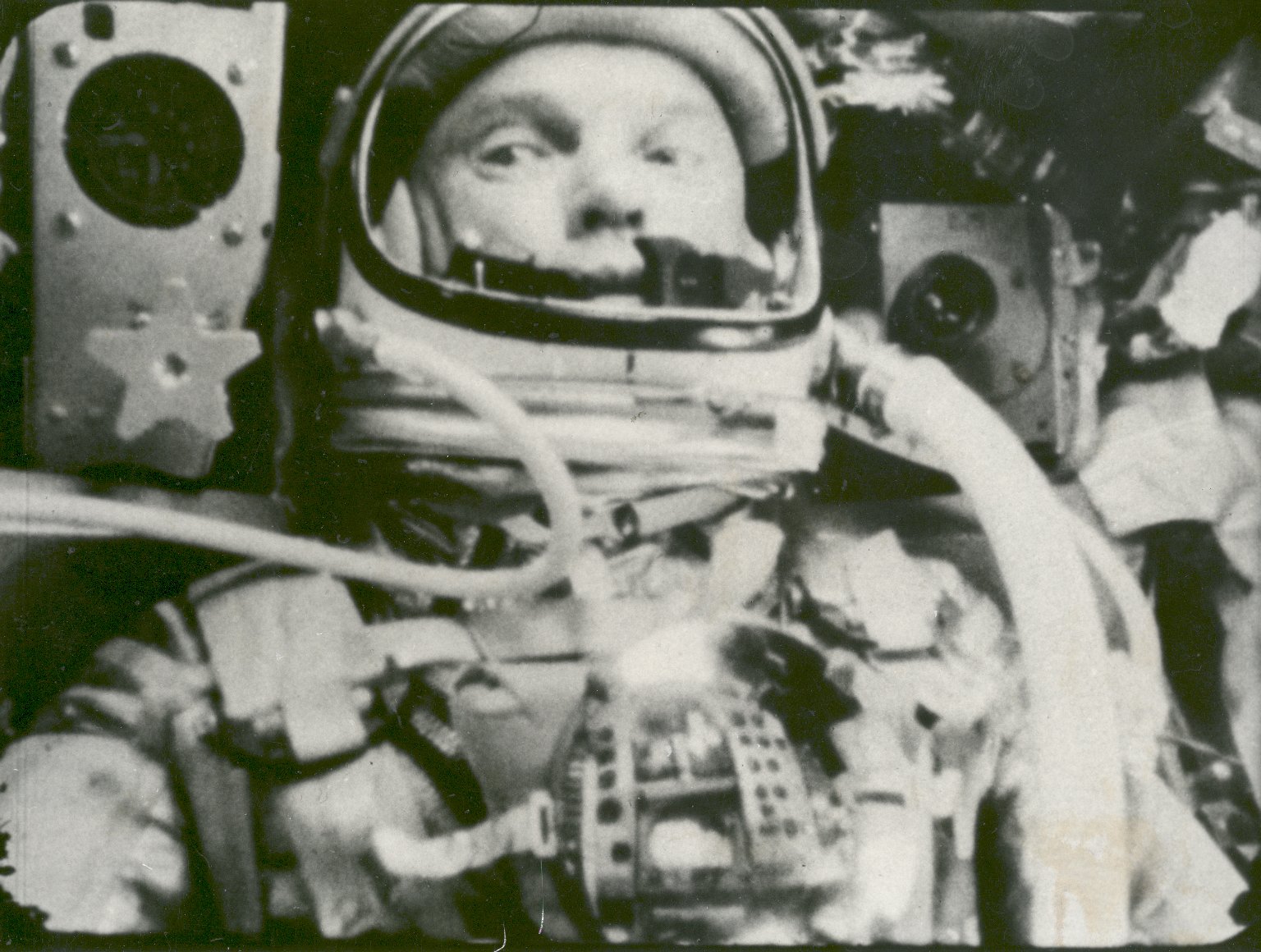
Glenn splashed down at 2:43:02 p.m. EST in the Atlantic Ocean 800 miles (1,300 km) east of Bermuda and was recovered by the destroyer USS Noa 21 minutes later, after the ship's lookouts spotted the Friendship 7's parachute. Upon examination of the capsule, it was revealed that the warning signal had been false, caused by a faulty switch in the heat shield circuit, which had indicated that the clamp holding the shield had been released prematurely, NASA's Mercury-Atlas 6 page explains.
The Mercury-Atlas 6 mission was successful. Glenn had become the first American in orbit.
On Feb. 23, 1962, President John F. Kennedy visited Glenn at Cape Canaveral, with the astronaut then addressing Congress on Feb. 26 and being honored in a ticker-tape parade in New York City on March 1, 1962.
John Glenn's political career
Though Glenn would never walk on the moon, his success boosted the U.S. space program to ride a wave that would lead to the Apollo 11 mission and the first human on the moon.
Glenn retired from NASA in January 1964, more than five years prior to this momentous achievement. He was promoted to colonel in October 1964 and retired from the Marine Corps on Jan. 1, 1965, to seek the Democratic nomination for a U.S. Senate seat in Ohio.
According to Britannica, some space historians say one reason for his retirement may have been that Glenn's status as a national hero had made him too valuable to risk sending on another space mission. But it was a much more mundane risk on terra firma that doomed Glenn's first bid for a Senate seat: One month after announcing his candidacy, he slipped in his bathroom, damaging his inner ear, and withdrew from the campaign to recover.
But the national hero wasn't done with Washington. In 1970, Glenn ran for the Senate again, narrowly losing in the primary. In 1974, he was elected U.S. senator from Ohio and reelected three times after that. In 1984, Glenn made an unsuccessful bid for the Democratic presidential nomination, but in 1992, Glenn was reelected as senator yet again, becoming the first popularly elected senator from Ohio to win four consecutive terms.
Fourteen years later, Glenn revealed that he wasn't finished with space adventures or record-breaking missions just yet.
John Glenn's return to space
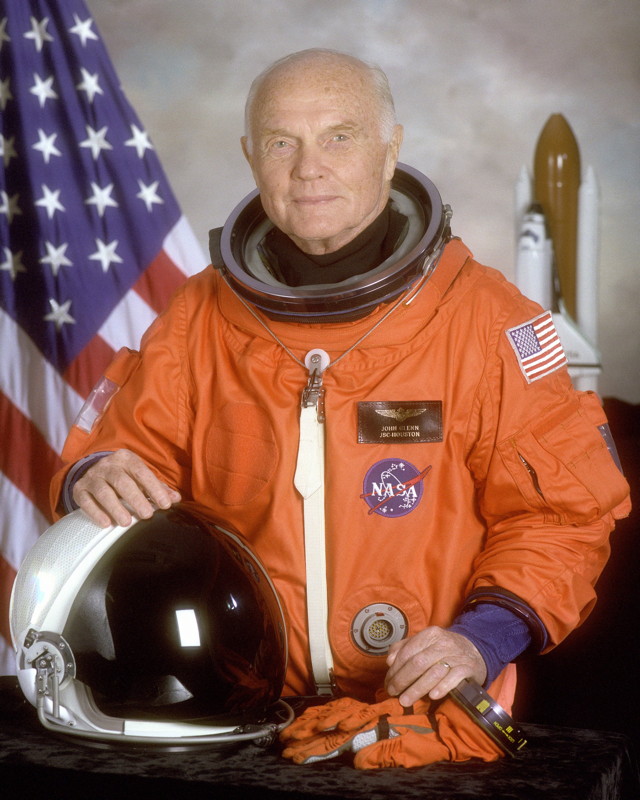
On Oct. 29, 1998, Glenn returned to space. This time, the astronaut left Earth aboard the space shuttle Discovery. As part of the nine-day STS-95 mission, Glenn served as a payload specialist. His involvement was also intended to determine the effect of space on older people, NASA explains. Glenn, who was 77 at the time, was the ideal choice for the mission, which made him the oldest person to journey into space until 2021.
The STS-95 mission also carried a variety of research payloads and deployed both the Spartan solar-observing spacecraft and the Hubble Space Telescope Orbital Systems Test Platform.
Glenn retired from the Senate in January 1999. On March 1 of that year, Glenn's contribution to the advancement of space science was recognized when the Lewis Research Center was officially renamed the NASA John H. Glenn Research Center at Lewis Field.
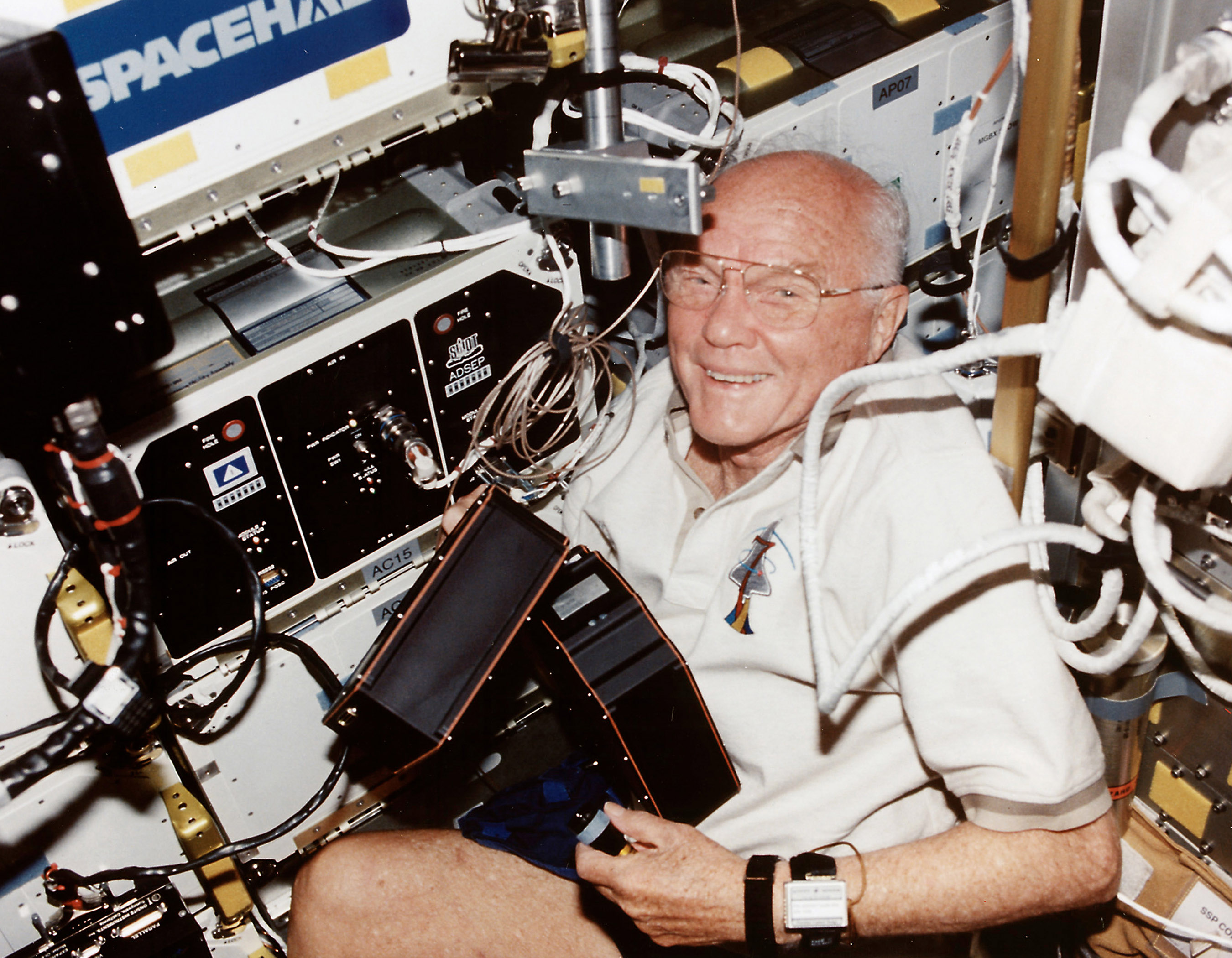
In 2000, he founded the John Glenn Institute for Public Service and Public Policy, which is now part of the John Glenn School of Public Affairs at The Ohio State University in Columbus. In 2012, at age 90, Glenn was awarded the Presidential Medal of Freedom by President Barack Obama.
"The first American to orbit the Earth, John Glenn became a hero in every sense of the word, but he didn't stop there serving his country," Obama said. "As a senator, he found new ways to make a difference. And on his second trip into space at age 77, he defied the odds once again. He reminds everybody, don't tell him he's lived a historic life. He says 'are living'; don't put it into the past tense because he still has a lot of stuff going on."
According to The New York Times, Glenn had undergone heart valve replacement surgery in 2014 and also suffered a stroke around the same time.
Glenn died on Dec. 8, 2016, at The Ohio State University Wexner Medical Center in Columbus, at 95 years old. Despite being the oldest of the Mercury 7, Glenn was its last surviving member. He was buried at Arlington National Cemetery.
John Glenn's personal life and wife
Glenn's wife of 73 years was Anna Margaret Glenn, born Anna Margaret Castor on Feb.y 17, 1920, in Columbus, Ohio, to Homer and Margaret (Alley) Castor. The pair had met at a young age and became high-school sweethearts.
Castor and Glenn were married on April 6, 1943. They had two children — John David, born in 1945, and Carolyn Ann, born in 1947 — as well as two grandchildren. Anna Margaret Glenn died on May 19, 2020, and was buried alongside her husband at Arlington National Cemetery.
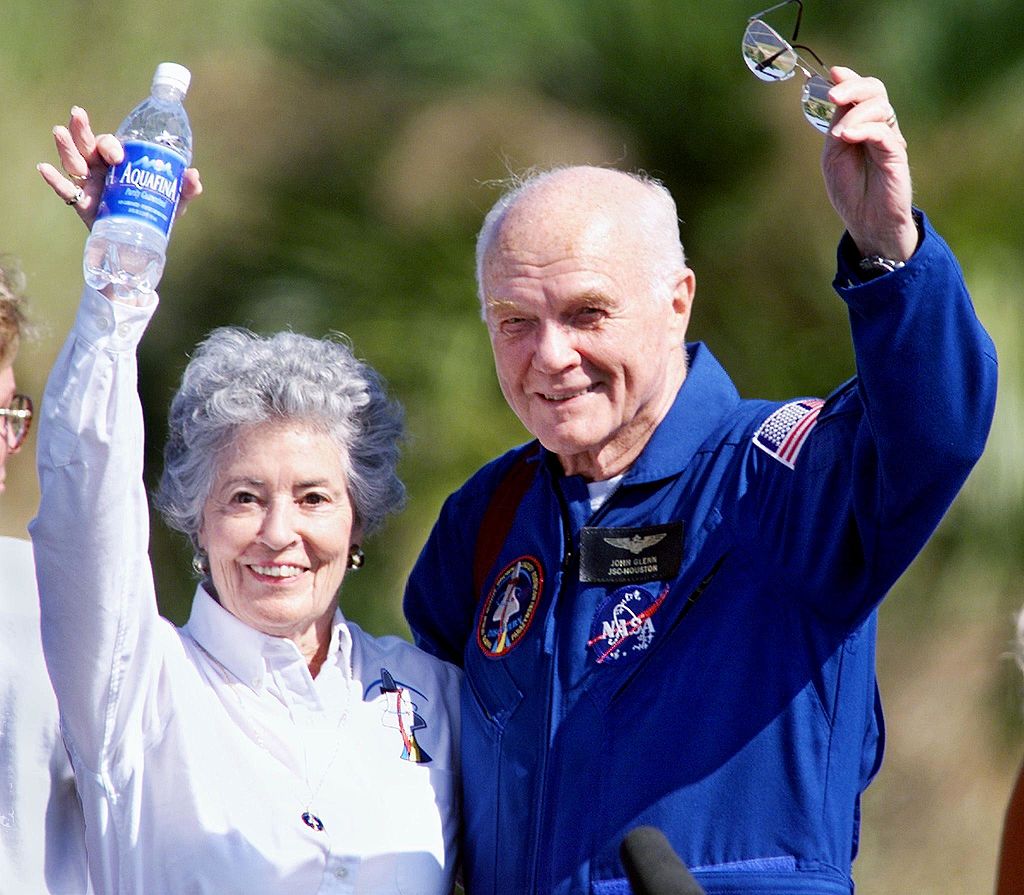
"The Right Stuff": John Glenn at the movies
Glenn is a major part of the 1983 movie "The Right Stuff," which was directed by Philip Kaufman and based on the book of the same name by Tom Wolfe. The film, in which John Glenn is portrayed by Ed Harris and Annie Glenn is played by Mary Jo Deschanel, tells the story of the beginnings of the U.S. space program and the Mercury 7 crew, starting with Chuck Yeager's breaking of the sound barrier in 1947. In a 2015 interview, John and Annie Glenn explained that although they had enjoyed Wolfe's book, they didn't care for Kaufman's movie adaptation.
In 2020, "The Right Stuff" book was also transformed into a Disney+ series of the same name, in which John Glenn was played by Patrick J. Adams and Annie Glenn was portrayed by Nora Zehetner. John and Annie Glenn are also portrayed in the 2015 TV series "The Astronaut Wives Club," based on the Lily Koppel novel of the same name — this time, played by Sam Reid and Azure Parsons, respectively.
Glen Powell played John Glenn in the 2016 movie "Hidden Figures," directed by Theodore Melfi, which tells the true story of a group of African American female mathematicians who served as the brains behind Glenn's launch into orbit. Glenn also appeared as himself in a 2001 episode of the television comedy "Frasier.",
Additional resources
Watch NASA footage introducing the Mercury 7 astronauts to the public on April 9, 1959, and learn more about the work of the other astronauts who formed this inaugural class of U.S. space heroes. See the 1962 newsreel telling the story of John Glenn's historic orbital flight. Look through photos of the Mercury 7 crew in training in this Life.com article.
Bibliography
Profile of John Glenn, NASA, [Accessed 07/10/23], [https://www.nasa.gov/content/profile-of-john-glenn]
John Glenn, Britannica, [Accessed 07/10/23], [https://www.britannica.com/biography/John-Glenn]
Who Was John Glenn? NASA, [Accessed 07/10/23], [https://www.nasa.gov/audience/forstudents/k-4/stories/nasa-knows/who-is-john-glenn-k4.html]
John Glenn becomes first American to orbit Earth, History Channel, [Accessed 07/10/23],[https://www.history.com/this-day-in-history/an-american-orbits-earth]
A.Chaikin., Godspeed, John Glenn—the Quintessential Astronaut, Scientific American, [2016], [https://www.scientificamerican.com/article/godspeed-john-glenn-mdash-the-quintessential-astronaut/]
Mercury-Atlas 6, NASA, [Accessed 07/10/23], [https://www.nasa.gov/mission_pages/mercury/missions/friendship7.html]
Oct. 29, 1998 - John Glenn Returns to Space, NASA, [Accessed 07/10/23], [https://www.nasa.gov/centers/glenn/about/bios/shuttle_mission.html]
Join our Space Forums to keep talking space on the latest missions, night sky and more! And if you have a news tip, correction or comment, let us know at: community@space.com.
Breaking space news, the latest updates on rocket launches, skywatching events and more!

Robert Lea is a science journalist in the U.K. whose articles have been published in Physics World, New Scientist, Astronomy Magazine, All About Space, Newsweek and ZME Science. He also writes about science communication for Elsevier and the European Journal of Physics. Rob holds a bachelor of science degree in physics and astronomy from the U.K.’s Open University. Follow him on Twitter @sciencef1rst.
